Construction of trails in the Mayapple Hill section of South Mountain Reservation from June through October 2012, has provided new urban hiking opportunities. Where the yellow-blazed Lenape Trail previously terminated at the southern end of the Mayapple Hill parking lot, it has now been extended from the opposite northern corner of the lot through a wooded undeveloped open space, which was...
Hike Description:
Construction of trails in the Mayapple Hill section of South Mountain Reservation from June through October 2012, has provided new urban hiking opportunities. Where the yellow-blazed Lenape Trail previously terminated at the southern end of the Mayapple Hill parking lot, it has now been extended from the opposite northern corner of the lot through a wooded undeveloped open space, which was added to South Mountain Reservation in 2009. This trail extension, in addition to a new loop trail around Mayapple Hill, forms an interconnecting network of trails.
To start the hike, locate the kiosk off to the side of the parking lot. Facing the kiosk, turn right and walk towards the white building off of a drive that exits the parking towards picnic areas. The yellow-blazed Lenape Trail starts just to the left of this restroom building. Follow the yellow blazes through the woods for about a quarter of a mile.
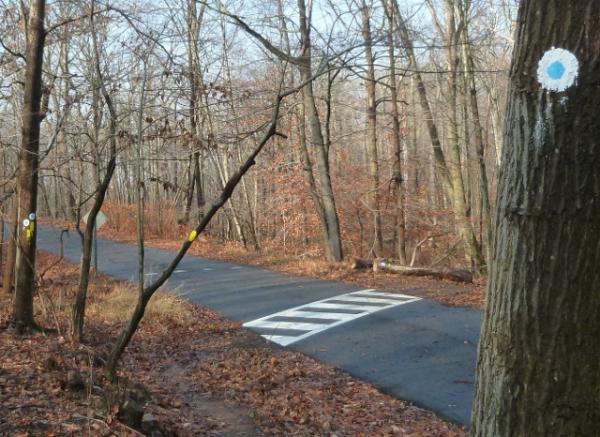 Just before a pedestrian crosswalk over paved Cedar Avenue, a park access road, the blue-dot-on-white-blazed trail joins in from the right. This new loop trail around Mayapple Hill will be the return route. For now follow the combined yellow/blue-dot-on-white trail over the crosswalk and back into the woods. At a short boardwalk over a wet area, the blue-dot-on-white blazes leave to the left. Stay with the yellow blazes for now but remember this intersection for later.
Just before a pedestrian crosswalk over paved Cedar Avenue, a park access road, the blue-dot-on-white-blazed trail joins in from the right. This new loop trail around Mayapple Hill will be the return route. For now follow the combined yellow/blue-dot-on-white trail over the crosswalk and back into the woods. At a short boardwalk over a wet area, the blue-dot-on-white blazes leave to the left. Stay with the yellow blazes for now but remember this intersection for later.
Continue on the yellow-blazed trail passing the entrance then the exit of the white/yellow loop trail. The yellow trail switchbacks sharply to the left at old concrete fence posts, descends and crosses a creek on wide, flat stepping stones, then ends at Whitbay Drive in BelAir Estates. This is the end of the Lenape Trail extension but the intent is to eventually continue the trail on the other side of Whitbay to join up with the main Lenape Trail near I-280 which will completely connect all of the main Essex County Parks. For now, retrace back to the first white/yellow trail blaze.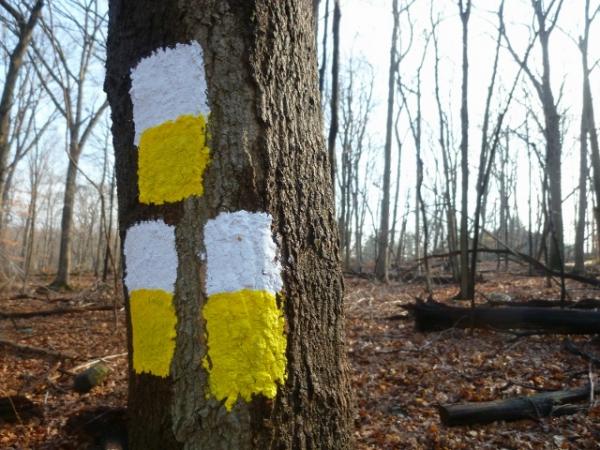
Turn left on the white/yellow trail for a half-mile loop then rejoin the yellow-blazed Lenape Trail continuing left. At the short boardwalk from earlier in the hike, turn right on the blue-dot-on-white trail. This trail will loop around the backside of Mayapple Hill with residences to the right. After the trail crosses over the original section of the Lenape Trail then paved Cedar Avenue, it continues along a ledge overlooking Orange Reservoir, South Mountain Arena and Turtle Back Zoo down to the right. A blue-line-on-white trail to the left provides a shortcut back to the parking lot but to get your full 4 miles worth, continue on until the blue-dot-on-white trail meets up with the yellow-blazed Lenape Trail at the crosswalk on Cedar Avenue from the beginning of the hike. Turn left here and follow the yellow blazes all the way back to the restroom building and the parking lot.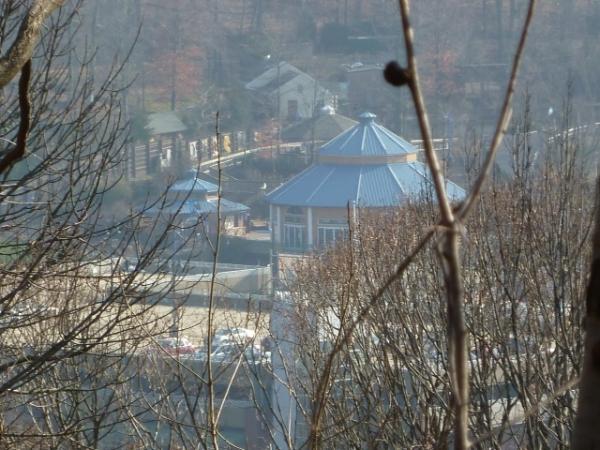
Turn By Turn Description:
[ 0.00] Start on the yellow-blazed Lenape Trail to the left of the restroom building
[ 0.25] Cross paved Cedar Avenue when blue-dot-on-white joins in from the right
[ 0.35] Keep straight on yellow when blue-dot-on-white leaves to the left at boardwalk
[ 0.40] Keep straight on yellow when white/yellow goes right
[ 0.80] Keep straight when white/yellow goes right (other end of white/yellow loop)
[ 1.00] Cross creek on large boulders
[ 1.25] Reach paved Whitbay Drive and retrace
[ 1.45] Cross creek on large boulders
[ 1.65] Turn left on white/yellow (at the time of this hike, white/yellow not yet cleared, lots of blow downs)
[ 2.20] Turn left on yellow when white/yellow ends
[ 2.25] Turn right on blue-dot-on-white at boardwalk when yellow goes left
[ 3.00] Blue dot trail turns left on unmarked coming in from right then leaves to the right when unmarked veers left
[ 3.10] Cross over old section of yellow-blazed Lenape Trail running parallel to Cedar Avenue
[ 3.15] Cross paved Cedar Avenue
[ 3.30] Keep straight when blue-line-on-white goes left back to the parking lot
[ 3.65] Cross paved Cedar Avenue then small creek
[ 3.75] Left on yellow Lenape Trail when yellow/blue dot crosses road to the right
[ 4.00] Back at parking lot
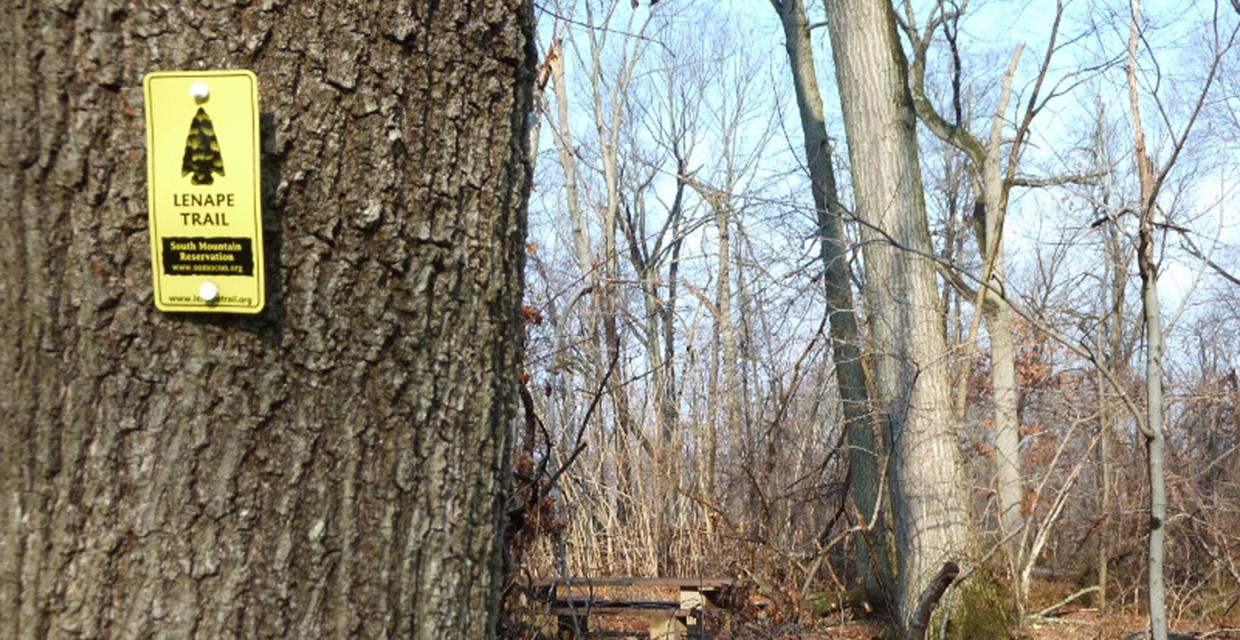
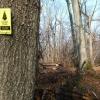
New trails on Mayapple Hill and through an undeveloped open space addition to South Mountain Reservation provide additional urban hiking opportunities.
Hike Checklist:
Whether you are going for a day hike or backpacking overnight, it is good practice to carry what we call The Hiking Essentials. These essentials will help you enjoy your outing more and will provide basic safety gear if needed. There may also be more essentials, depending on the season and your needs.
The Essentials
Hiking Shoes or Boots
Water - Two quarts per person is recommended in every season. Keep in mind that fluid loss is heightened in winter as well as summer. Don't put yourself in the position of having to end your hike early because you have run out of water.
Map - Know where you are and where you are going. Many of our hiking areas feature interconnecting network of trails. Use a waterproof/tear-resistant Tyvek Trail Conference map if available or enclose your map in a Ziplock plastic bag. If you have a mobile device, download Avenza’s free PDF Maps app and grab some GPS-enhanced Trail Conference maps (a backup Tyvek or paper version of the map is good to have just in case your batteries die or you don't have service). Check out some map-reading basics here.
Food - Snacks/lunch will keep you going as you burn energy walking or climbing. Nuts, seeds, and chocolate are favorites on the trail.
Sunscreen and insect repellent
Rain Gear and Extra Clothing - Rain happens. So does cold. Be prepared for changing weather. Avoid cotton--it traps water against your skin and is slow to dry. If you are wearing wet cotton and must return to your starting point, you risk getting chills that may lead to a dangerous hypothermia. Choose synthetic shirts, sweaters and/or vests and dress in layers for easy on and off.
Compass - A simple compass is all you need to orient you and your map to magnetic north.
Light - A flashlight or small, lightweight headlamp will be welcome gear if you find yourself still on the trail when darkness falls. Check the batteries before you start out and have extras in your pack.
First Aid Kit - Keep it simple, compact, and weatherproof. Know how to use the basic components.
Firestarter and Matches - In an emergency, you may need to keep yourself or someone else warm until help arrives. A firestarter (this could be as simple as leftover birthday candles that are kept inside a waterproof container) and matches (again, make sure to keep them in a waterproof container) could save a life.
Knife or Multi-tool - You may need to cut a piece of moleskin to put over a blister, repair a piece of broken equipment, or solve some other unexpected problem.
Emergency Numbers - Know the emergency numbers for the area you're going to and realize that in many locations--especially mountainous ones, your phone will not get reception.
Common Sense - Pay attention to your environment, your energy, and the condition of your companions. Has the weather turned rainy? Is daylight fading? Did you drink all your water? Did your companion fail to bring rain gear? Are you getting tired? Keep in mind that until you turn around you are (typically) only half-way to completing your hike--you must still get back to where you started from! (Exceptions are loop hikes.)
Check the weather forecast before you head out. Know the rules and regulations of the area.
The Leave No Trace Seven Principles
Plan Ahead and Prepare
- Know the regulations and special concerns for the area you'll visit.
- Prepare for extreme weather, hazards, and emergencies.
- Schedule your trip to avoid times of high use.
- Visit in small groups when possible. Consider splitting larger groups into smaller groups.
- Repackage food to minimize waste.
- Use a map and compass to eliminate the use of marking paint, rock cairns or flagging.
Travel and Camp on Durable Surfaces
- Durable surfaces include established trails and campsites, rock, gravel, dry grasses or snow.
- Protect riparian areas by camping at least 200 feet from lakes and streams.
- Good campsites are found, not made. Altering a site is not necessary.
- In popular areas:
- Concentrate use on existing trails and campsites.
- Walk single file in the middle of the trail, even when wet or muddy.
- Keep campsites small. Focus activity in areas where vegetation is absent.
- In pristine areas:
- Disperse use to prevent the creation of campsites and trails.
- Avoid places where impacts are just beginning.
- Pack it in, pack it out. Inspect your campsite and rest areas for trash or spilled foods. Pack out all trash, leftover food and litter.
- Deposit solid human waste in catholes dug 6 to 8 inches deep, at least 200 feet from water, camp and trails. Cover and disguise the cathole when finished.
- Pack out toilet paper and hygiene products.
- To wash yourself or your dishes, carry water 200 feet away from streams or lakes and use small amounts of biodegradable soap. Scatter strained dishwater.
- Preserve the past: examine, but do not touch cultural or historic structures and artifacts.
- Leave rocks, plants and other natural objects as you find them.
- Avoid introducing or transporting non-native species.
- Do not build structures, furniture, or dig trenches.
- Campfires can cause lasting impacts to the backcountry. Use a lightweight stove for cooking and enjoy a candle lantern for light.
- Where fires are permitted, use established fire rings, fire pans, or mound fires.
- Keep fires small. Only use sticks from the ground that can be broken by hand.
- Burn all wood and coals to ash, put out campfires completely, then scatter cool ashes.
- Observe wildlife from a distance. Do not follow or approach them.
- Never feed animals. Feeding wildlife damages their health, alters natural behaviors, and exposes them to predators and other dangers.
- Protect wildlife and your food by storing rations and trash securely.
- Control pets at all times, or leave them at home.
- Avoid wildlife during sensitive times: mating, nesting, raising young, or winter.
Be Considerate of Other Visitors
- Respect other visitors and protect the quality of their experience.
- Be courteous. Yield to other users on the trail.
- Step to the downhill side of the trail when encountering pack stock.
- Take breaks and camp away from trails and other visitors.
- Let nature's sounds prevail. Avoid loud voices and noises.
The Trail Conference is a 2015 Leave No Trace partner.
(c) Leave No Trace Center for Outdoor Ethics: www.LNT.org.


